Cisco eSIM Flex White Paper
Available Languages
Bias-Free Language
The documentation set for this product strives to use bias-free language. For the purposes of this documentation set, bias-free is defined as language that does not imply discrimination based on age, disability, gender, racial identity, ethnic identity, sexual orientation, socioeconomic status, and intersectionality. Exceptions may be present in the documentation due to language that is hardcoded in the user interfaces of the product software, language used based on RFP documentation, or language that is used by a referenced third-party product. Learn more about how Cisco is using Inclusive Language.
Enable global connectivity for enterprises and service providers with Cisco eSIM Flex
Streamline IoT device management across borders
IoT device manufacturers face challenges managing cellular connectivity across regions. Traditional SIM cards require complex logistics, since they are network specific. eSIM technology, driven by the connected car industry, offers a solution through remote carrier reprogramming. To address integration challenges, Cisco developed eSIM Flex, a cloud-based platform that simplifies multicarrier partnerships, enabling service providers to scale global IoT connectivity more efficiently.
International enterprises that manufacture IoT-enabled devices need reliable, cost-effective cellular service around the globe. Typically, these enterprises manufacture and test devices in one or more centralized locations and then sell those devices to customers in different countries. In some cases, the devices themselves are mobile, moving from one location to another. This business model requires network services for the devices in multiple countries covered by multiple carriers.
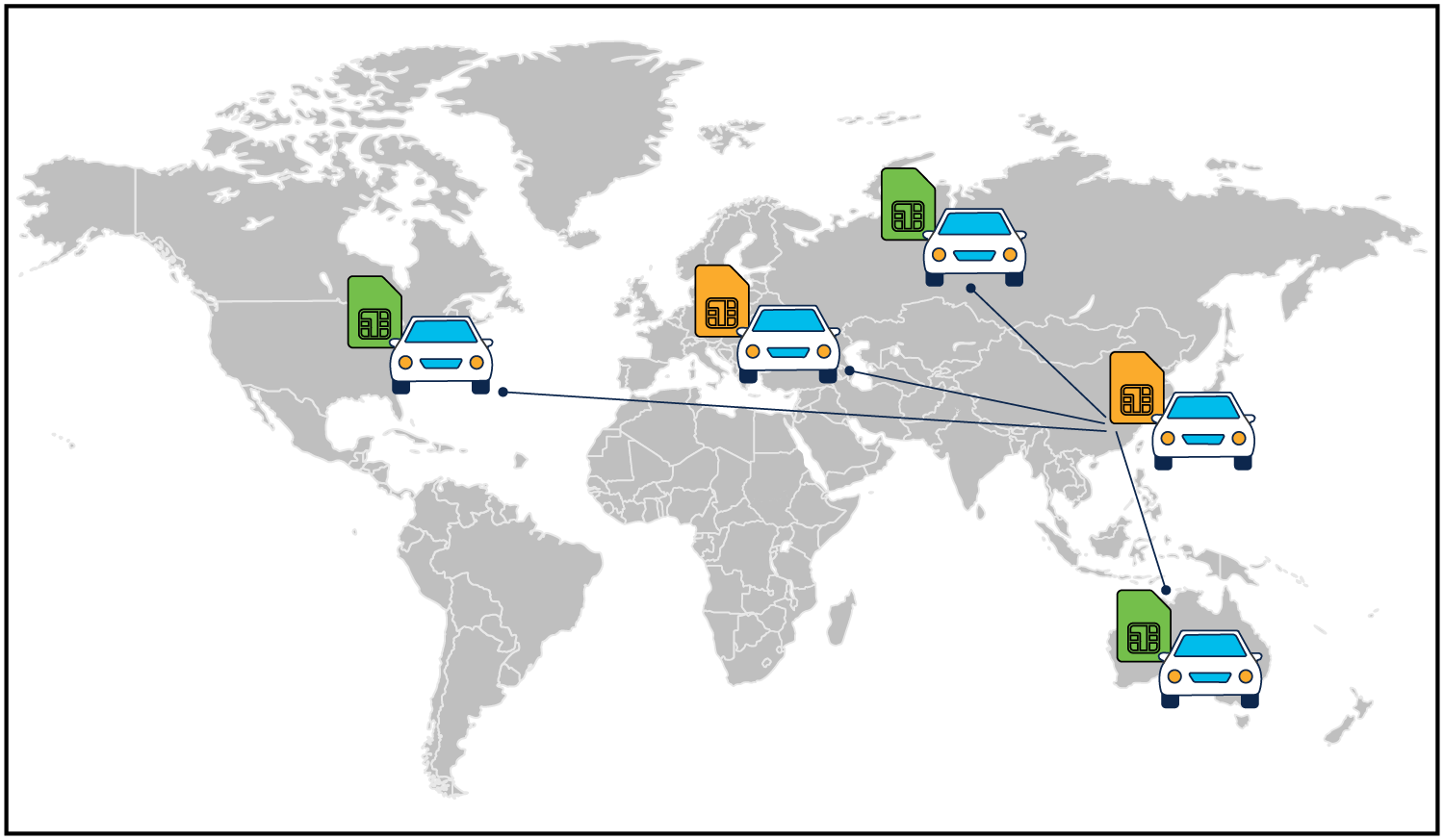
The global IoT connectivity challenge
IoT devices manufactured in one location need connectivity wherever they are sold.
To address this business need, enterprises are turning to reprogrammable SIM cards, also called eSIMs. A standard SIM card contains a profile (also known as a subscription) that associates the card, and the device that contains it, with a particular carrier and allows the device to use cellular services provided by that carrier. By contrast, an eSIM card can store multiple profiles downloaded from different carriers, allowing the device to switch from one carrier to another depending on location, regulatory requirements, service pricing, or network performance. Cisco® eSIM Flex is a turnkey eSIM solution that allows you to easily download and activate profiles over the air on an eSIM. Once these profiles are on an eSIM, you can quickly switch between profiles, depending on the business use case.
Commercial agreements. Before using eSIM Flex, an enterprise must have commercial agreements with any carriers that provide service to their eSIMs. Depending on the business arrangement, some carriers may have agreements with one another as well.
Traditionally, a SIM card is associated with a single carrier network. The carrier identifies each SIM by a profile that includes three types of data:
● ICCID: A unique identifier, like a serial number, often printed directly on the SIM card.
● IMSI: A unique number composed of a country code, a mobile network code, and a mobile subscription ID number.
● MSISDN: A phone number.
The carrier sells SIM cards to the enterprise and then charges an ongoing subscription fee for the use of network services through the SIM card. An eSIM card has one unique identifier, an eSIM ID, also called an eID. In addition, the eSIM has slots for numerous profiles from a variety of carriers. Only one profile is active at a time. This profile determines which carrier the eSIM can use.
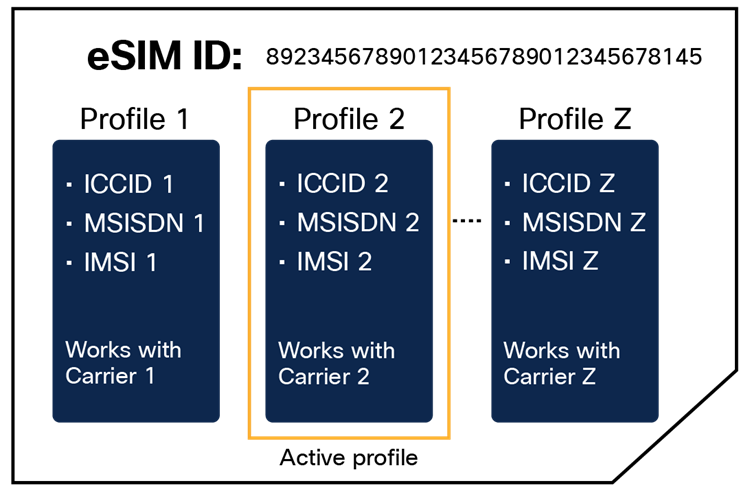
eSIM active profiles
An eSIM can have multiple network profiles.
An enterprise purchases an eSIM card with a preloaded profile that is associated with its carrier of choice.
A carrier is a service provider that offers voice and data services to the public through its network infrastructure.
The carrier that provides the eSIM and the preloaded profile is the lead carrier. The enterprise can choose to localize the eSIM to another carrier by downloading that carrier’s profile. This carrier is referred to as the partner carrier.
The carrier swap process consists of three main steps: profile allocation, profile download, and profile activation.
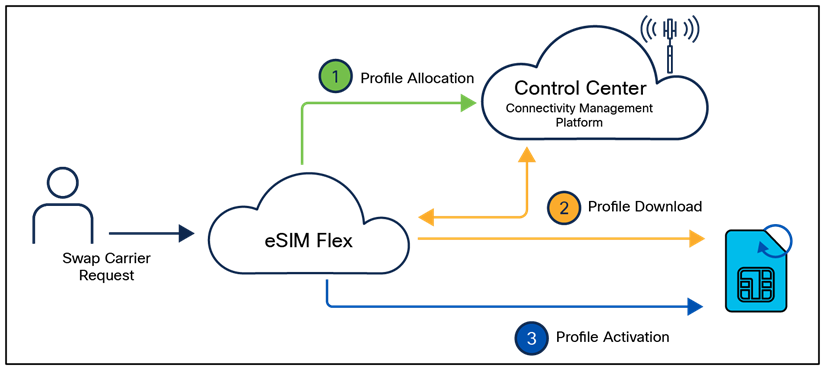
Simplifying the carrier swap process with Cisco eSIM Flex
Table 1. Swap tasks
| Task |
Description |
| 1. Profile allocation |
eSIM Flex asks the target carrier to transfer a new profile from its inventory account into the enterprise account in its Connectivity Management Platform (CMP). The target carrier then provisions the profile on its network. |
| 2. Profile download |
eSIM Flex downloads the new profile from the target carrier onto the eSIM card. |
| 3. Profile activation |
eSIM Flex activates the profile on the card so the eSIM can begin using network services from the target carrier. |
A new eSIM with only one profile must go through all three steps when swapping from a lead carrier to a partner or target carrier. However, if the eSIM already contains a profile for the target carrier, only the final step, profile activation, is required to complete the swap.
IoT Control Center vs. other carriers
eSIM Flex is designed to work with Cisco IoT Control Center. eSIM Flex is already preintegrated with all carrier instances of Control Center. This integration allows on-the-fly allocation of a profile from the target carrier and provisioning of that profile in the Control Center enterprise account with the proper rate plan and communication plan settings.
eSIM Flex also integrates with other connectivity management platforms used by select carriers. If the target carrier is not integrated, eSIM Flex allows you to control the allocation and provisioning process directly, outside of eSIM Flex. In this scenario, you can use eSIM Flex APIs to perform eSIM functions and use the target carrier APIs to perform provisioning functions.
For target carriers that use Control Center, eSIM Flex automatically sets the device SIM status to Activated, so the device is immediately billable after the swap. For target carriers that do not use Control Center, the customer must manage the device status after the swap. eSIM Flex activates the target carrier's profile on the eSIM but does not set the device's billable or connectivity status on the target carrier. It sets the device's status to billable if the target carrier's profile is hosted on Control Center.
In both cases, eSIM Flex does not change the SIM status on the original carrier, so the profile remains provisioned on the original network. This allows the customer to use the fallback feature on the eSIM if the swap fails. The customer must decide whether to deactivate the device on the original carrier or keep it active. Be aware that in Control Center, active devices are billable.
An eSIM Flex carrier can be a lead carrier, a partner carrier, or both. A lead carrier provides the initial eSIM to the enterprise, provides remote SIM provisioning capability to the platform, and can work with partner carriers to localize eSIMs in other geographical locations of interest.
Each carrier type has different responsibilities in the eSIM swapping process, as shown in the table below.
Table 2. Carrier type responsibilities in the eSIM swapping process
| Action |
Lead carrier |
Partner carrier |
| Procures eSIMs and supplies them to enterprises |
✓ |
|
| Must have an eSIM Flex carrier account |
✓ |
|
| Provides the preloaded eSIM profile |
✓ |
|
| Provides access to operational eSIM profiles |
|
✓ |
How carriers monetize eSIM deployment on eSIM Flex
The lead carrier can adopt two different connectivity models to drive its eSIM business and generate value for enterprises using eSIM technology:
● Connectivity handover model
● Connectivity resale model
Connectivity handover model
With the connectivity handover model, the lead carrier generates value for the enterprise by localizing the eSIM, which reduces roaming costs. This model also generates value for partner carriers by driving business to them.
In this model the lead carrier has a connectivity agreement with an enterprise. The enterprise establishes connectivity contracts with multiple partner carriers based on preference and location.
When the enterprise executes a carrier swap using eSIM Flex, the connectivity and customer relationship management is handed over from the lead carrier to the partner carrier whose profile is currently active on the eSIM.
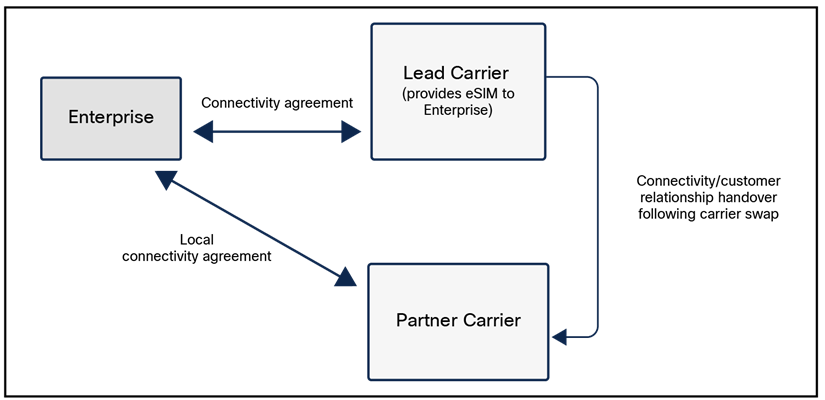
eSIM Flex connectivity handover model
Connectivity resale model
With the connectivity resale model, the lead carrier generates value for the enterprise by providing global connectivity under one business relationship. This model also generates value for partner carriers by reselling connectivity.
In this model the enterprise establishes a single global connectivity agreement with the lead carrier, which in turn resells connectivity from the partner carriers that are serving in the enterprise's operation locations.
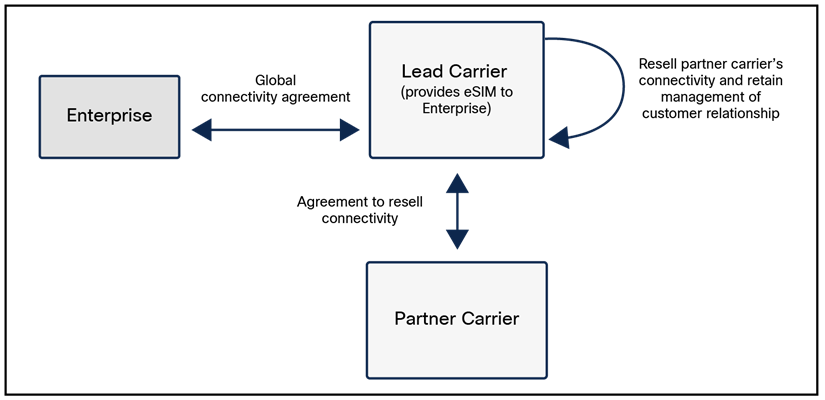
eSIM Flex connectivity resale model
eSIM technology, particularly through solutions like Cisco's eSIM Flex, represents a significant advancement in managing global IoT device connectivity. The platform offers two viable business models—the connectivity handover model and the connectivity resale model—enabling carriers to effectively monetize eSIM deployment while providing enterprises with flexible connectivity solutions. By simplifying the carrier swap process and supporting both Cisco IoT Control Center and other carriers, eSIM Flex addresses the complex challenges of international IoT device deployment. This comprehensive approach to eSIM management helps enterprises reduce roaming costs and streamline their global connectivity operations under either single-carrier or multiple-carrier relationships, making it a practical solution for the evolving demands of IoT device manufacturers.
As the global leader in connected car SIM management through IoT Control Center, Cisco understands the eSIM challenge intimately. Drawing on insights from our service provider partners, we’ve developed eSIM Flex—a revolutionary cloud-based solution that transforms the traditional eSIM approach. This innovation harnesses advanced technology to enable seamless multicarrier global partnerships, making us the first to deliver comprehensive eSIM benefits without complex integration requirements.
eSIM Flex dramatically simplifies service provider operations. Instead of maintaining an ever-growing integration support team, providers can serve unlimited global manufacturing customers through a single integration point. Consider this: A traditional five-provider global partnership requires maintaining 55 separate integrations. With eSIM Flex, just five integrations accomplish the same goal. Our cloud-based platform offers granular control through per-customer partnership configurations, while providing both an intuitive portal interface and robust APIs for supply chain integration.
The IoT landscape is expanding rapidly across connected cars, meters, heavy equipment, and robotics. As global manufacturers increasingly demand streamlined cellular connectivity solutions, eSIM Flex positions service providers to scale efficiently and cost-effectively. Through this innovation, Cisco continues to empower our partners to meet evolving market demands and drive the future of IoT connectivity.
To learn how Cisco eSIM Flex and IoT Control Center can propel your organization's IoT initiatives to new heights, visit the Cisco IoT Control Center homepage.
To learn more about Cisco’s Mobility Services Platform, read the Mobility Services Platform solution overview.
To schedule a demonstration of Cisco eSIM Flex and IoT Control Center, contact your Cisco sales representative.